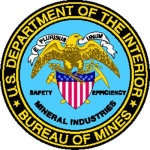- Industry: Mining
- Number of terms: 33118
- Number of blossaries: 0
- Company Profile:
The U.S. Bureau of Mines (USBM) was the primary United States Government agency conducting scientific research and disseminating information on the extraction, processing, use, and conservation of mineral resources.
Founded on May 16, 1910, through the Organic Act (Public Law 179), USBM's missions ...
A process in which strong suction is advocated at all times with the dense-medium process, since none of the bone medium must be allowed to get over into the washed coal.
Industry:Mining
A process in which zinc is distilled and the vapor burned to produce the oxide; the purity of the oxide is controlled by the purity of the metal.
Industry:Mining
A process of alternate excavation and refilling of a channel, as by a stream or the tides; esp. such a process occurring in time of flood when the discharge and velocity of an aggrading stream are suddenly increased, causing the digging of new channels that become filled with sediment when the flood subsides.
Industry:Mining
A process of alternate excavation and refilling of a channel, as by a stream or the tides; esp. such a process occurring in time of flood when the discharge and velocity of an aggrading stream are suddenly increased, causing the digging of new channels that become filled with sediment when the flood subsides.
Industry:Mining
A process of coalification in which fusain is formed. Compare: incorporation; vitrinization. Also spelled: fusainisation.
Industry:Mining
A process of concentrating iron ore that comprises the steps of (1) effecting a dry, thermal, partial reduction of the iron in the ore to the metallic state to a degree of reduction of between 50% and 80%, (2) subjecting the reduced product to a magnetic separation, and (3) recovering the magnetic concentrate.
Industry:Mining
A process of decarbonization on a siliceous hearth in which the conversion is effected rather by the flame than by the reaction of solid or fused materials. As the amount of carbon diminishes, the mass becomes fusible and begins to coagulate (come to nature), after which it is worked together into lumps (puddle balls, loups) and removed from the furnace to be hammered (shingled) or squeezed in the squeezer, which presses out the cinder, etc., and compacts the mass at welding heat, preparatory to rolling. Silicon and phosphorus are also largely removed by puddling, passing into the cinder.
Industry:Mining
A process of decomposition of organic substances that occurs in the presence of water and with the complete exclusion of air. It is a kind of slow distillation whereby chiefly methane (CH<sub>4</sub>) and smaller quantities of other gaseous products, such as hydrogen (H<sub>2</sub>), ammonia (NH<sub>3</sub>), and hydrogen sulfide (H<sub>2</sub>S), are formed. Compare: disintegration
Industry:Mining
A process of electrodepositing hard chromium on the wearing surfaces of parts as a protection against wear by friction.
Industry:Mining
A process of engraving in which lines, frosting, or roughening are produced by an acid or mordant. Often used in studying the composition and structure of metals, sandgrains, and crystals.
Industry:Mining
